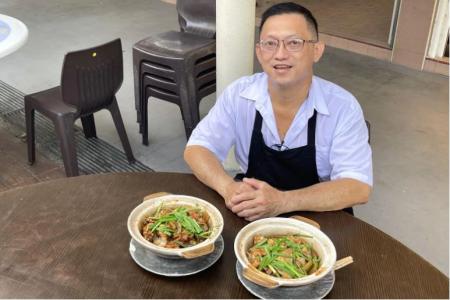How to make frozen chicken tasty
Malaysia's temporary export ban on fresh chicken has kicked in, but zi char chef Hoong Boon Leong is unperturbed.
The 46-year-old, co-owner of Wang Lee Seafood Restaurant, a coffee-shop stall in Toa Payoh, uses mostly frozen meats for his dishes.
He says: "It is a common misconception that frozen chicken is inferior to fresh chicken."
What puts people off frozen chicken is the "frozen" odour in the cooked meat, which he says comes from the blood water in the chicken bones.
The blood water can be dealt with by blanching the chicken in hot oil or water.
"If you apply the right techniques to preparing and cooking frozen chicken, it can taste as good, if not better, than fresh chicken," chef Hoong says.
His signature dish, Fragrant Chicken (Zhao Pai Jin Xiang Ji), is made using frozen chicken leg and wing.
He says: "Most customers cannot tell the difference between frozen and fresh chicken. I have encountered a few customers who thought I used fresh chicken in my signature dish."
Every week, his stall uses up to 50kg of frozen chicken legs, wings and boneless thighs. Chicken is the most popular meat option among his customers.
He says: "Frozen chicken parts are more convenient to handle than carving up whole fresh chickens."
Chilled fresh chickens are not a viable option for his business as they must be used within two days or the meat quality deteriorates rapidly. At his stall, chef Hoong has more freezer than chiller storage.
The only times he uses fresh chicken are when regulars request off-menu items such as soya sauce chicken and curry chicken. This is because customers prefer whole chickens for such dishes and his frozen chicken is supplied in parts.
He says: "When you cook curry chicken with fresh chicken, the chicken carcass and bony parts add flavour to the dish."
The main difference between frozen and fresh chicken is the texture, he says.
Fresh chicken has more moisture in the meat and retains its shape better when cut. Frozen chicken, once defrosted, is not as firm in texture, which is why it requires a longer marinating time to plump up the meat and thoroughly infuse it with flavour.
Taste test: Frozen versus fresh chicken
Chef Hoong uses the same recipe to whip up two dishes of claypot ginger scallion chicken - one using fresh chicken and the other frozen chicken.
Appearance
When raw, the pieces of cut fresh chicken retain their shape. The defrosted chicken looks slightly slack and leaves a bloody trail on the plate. When cooked, the fresh chicken also keeps its shape well, and looks plump and firm. When you look at the two dishes side by side, the meat and skin of the chicken prepared with frozen poultry appears a little more shrunken.
Texture
The fresh chicken meat has a firm bite, feels more compact and dense, and clings more tightly to the bone. The skin is supple and slippery. The defrosted chicken is more tender, but has a slightly bouncy texture from the use of cornstarch in the marinade.
Flavour
The two dishes taste similar. The same seasoning is used and the marinade has penetrated the meats and infused them with flavour. There is no detectable frozen odour in the defrosted chicken meat.
Verdict
I prefer fresh chicken for its firm texture and bite. But for those who like their meat tender, frozen chicken is probably the better option. Flavour-wise, the frozen chicken does not lose out to fresh chicken because it is well-marinated and well-seasoned.
Claypot ginger scallion chicken by Chef Hoong Boon Leong
Ingredients
• 500g chicken (leg and wing)
• 900ml oil (for blanching the chicken)
• 35g ginger, sliced
• 30g garlic cloves, halved
• 60g red onion, sectioned
• 1 tsp sesame oil
• 50g green onion, cut into 5cm lengths, separate the bottom white ends from the green parts
• 3 Tbs white rice wine
Marinade
• 1½ tsp Hua Tiao wine
• 3 tsp light soya sauce
• ½ tsp salt
• ½ tsp sugar
• ½ egg white
• 2 tsp cornflour
• 1 Tbs water
Seasoning
• 1½ tsp oyster sauce
• 1 tsp light soya sauce
• 1 tsp dark soya sauce
• ¾ tsp sugar
• 1 Tbs Hua Tiao wine
• ½ tsp fish sauce
• 200ml water
Method
1. Cut the chicken into 6cm pieces.
2. Place the chicken in a deep dish and add the ingredients for the marinade - Hua Tiao wine, light soya sauce, salt, sugar, egg white and cornflour. Mix well. Add the water and continue mixing until the marinade is evenly mixed. For fresh chicken, marinate for 30 minutes to three hours. For frozen chicken, marinate for two hours or overnight.
3. In a wok, heat 900ml oil. Once the oil reaches 170 to 180 deg C, place the chicken in it.
4. Add the ginger and garlic. Switch off the heat. Allow the chicken to sit in the hot oil for three to four minutes until it turns opaque and blood water stops running out of the bones.
5. Remove the chicken, ginger and garlic from the oil and place them in a colander or frying strainer to drain off excess water.
6. Heat 1 Tbs of oil over medium heat in a wok. Add the red onion and fry for 10 seconds.
7. Add the oyster sauce under the seasoning list, chicken, ginger and garlic. Stir-fry for 10 seconds.
8. Add the light soya sauce, dark soya sauce, sugar, Hua Tiao wine and fish sauce. Stir-fry for 20 seconds.
9. Add 200ml water. Turn the heat up to high. Cover and cook the chicken for two to three minutes.
10. Heat a clean claypot. Add 1 tsp of sesame oil and the white bottom ends of the green onion. Cook for 30 seconds.
11. Add 3 Tbs of white rice wine. Transfer the chicken into the claypot.
12. Add the remaining green onion.
13. Serve immediately.
Serves four
- Claypot Ginger Scallion Chicken ($11 for small, $16 for medium) is available at Wang Lee Seafood Restaurant, 01-30 Yi Hao Coffee Shop, Block 94 Toa Payoh Lorong 4; tel: 8711-5600; opens: noon to 10.45pm daily.
Three Cup Chicken

Frozen chicken works well for Three Cup Chicken. ST PHOTO: HEDY KHOO Even before Malaysia's export ban on fresh chicken, I have found frozen mid-joint wings, available in 1kg bags, to be a convenient option to cook and eat.
For instance, I use them to make Three Cup Chicken, which got its name from the supposed use of one cup each of sesame oil, wine and soya sauce. In practice, using such quantities will not result in a palatable dish.
To save time, I do not blanch or marinate the wings. Instead, I fry them in ginger, garlic and a little Chinese rose wine to get rid of any unpleasant odours. Chinese white rice wine and Shaoxing wine also rid the meat of odours and infuse it with flavour.
What makes the dish distinctive is the use of basil. It is called jiu ceng ta in Mandarin, which translates literally to nine-storey pagoda.
Use Thai basil, which has a sweet aroma and purple stems. I add half of the leaves during the cooking process and throw in the rest once the dish is done.
Although I list the amount here as 17g - the weight of the leaves after removing them from 40g worth of stalks - it is up to you how much you want to use.
Cook the dish at a lower temperature and stir-fry at intervals to prevent the chicken from getting burnt. As this recipe does not involve marinating the meat, I prefer to cook the dish ahead and let it stew in residual heat for an hour. This is energy-saving and allows the flavours to steep into the chicken.
Ingredients
• 40ml sesame oil
• 40g ginger, slice half and julienne half
• 850g mid-joint wings (21 pieces)
• 2 drops of Chinese rose wine
• 3 garlic cloves (25g), sliced
• 3 Tbs Chinese white rice wine (bai mi jiu)
• 2 Tbs Shaoxing wine
• 50ml light soya sauce
• 1 tsp sugar
• 3 pandan leaves, knotted
• 3 green finger chillies (45g)
• 17g Thai basil leaves
Method
1. In a frying pan, heat the sesame oil over medium heat.
2. Add the ginger slices and fry for 30 seconds. Add the wings and fry for 30 seconds. Add the julienned ginger and mix well.
3. Stir-fry the chicken wings for three minutes and add the Chinese rose wine. Stir-fry for another minute and add the garlic. Fry for another two minutes until the wings are slightly brown.
4. Add the rice wine and half of the Shaoxing wine. Add the light soya sauce and sugar.
5. Stir-fry to distribute the seasoning.
6. Add the pandan leaves. Lower the heat, cover and cook for five minutes.
7. Add the green chillies and half of the Thai basil leaves. Cover and cook for another 15 minutes.
8. Switch off the heat. Keep the frying pan covered and let the wings cook in residual heat for an hour.
9. Heat the pan over low heat until the gravy simmers. Add the remaining Shaoxing wine and Thai basil leaves.
10. Switch off the heat and stir through briefly. Serve hot.
Serves four to five
- Follow Hedy Khoo on Instagram and Straits Times Food on Instagram and Facebook
Get The New Paper on your phone with the free TNP app. Download from the Apple App Store or Google Play Store now


